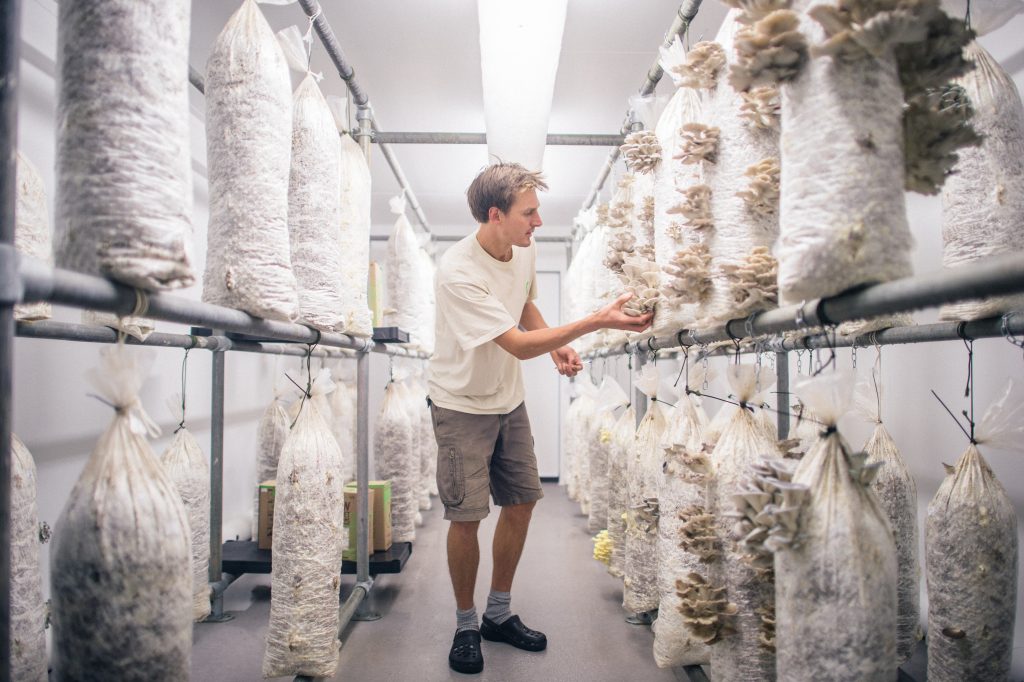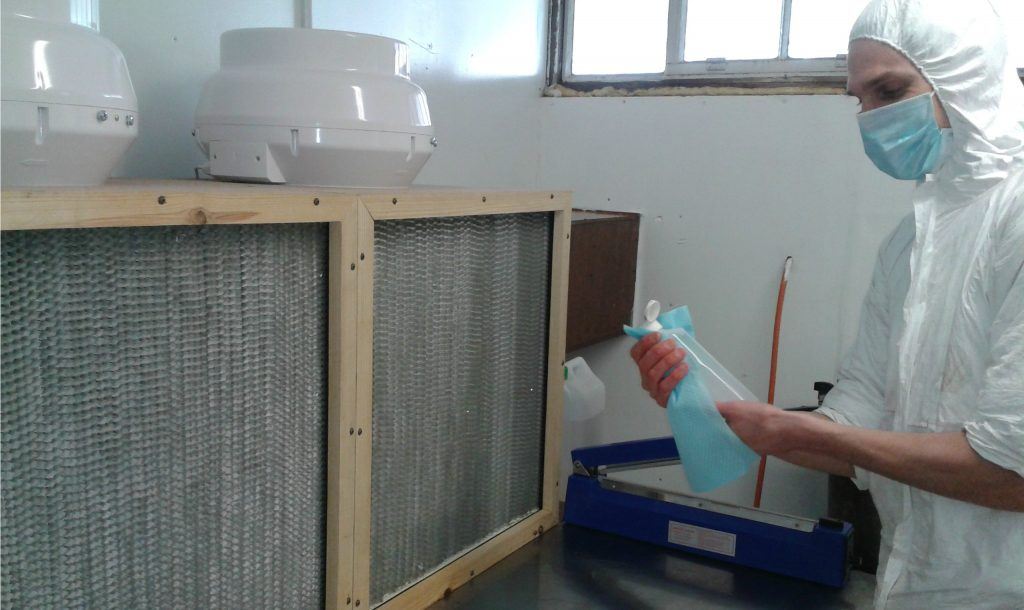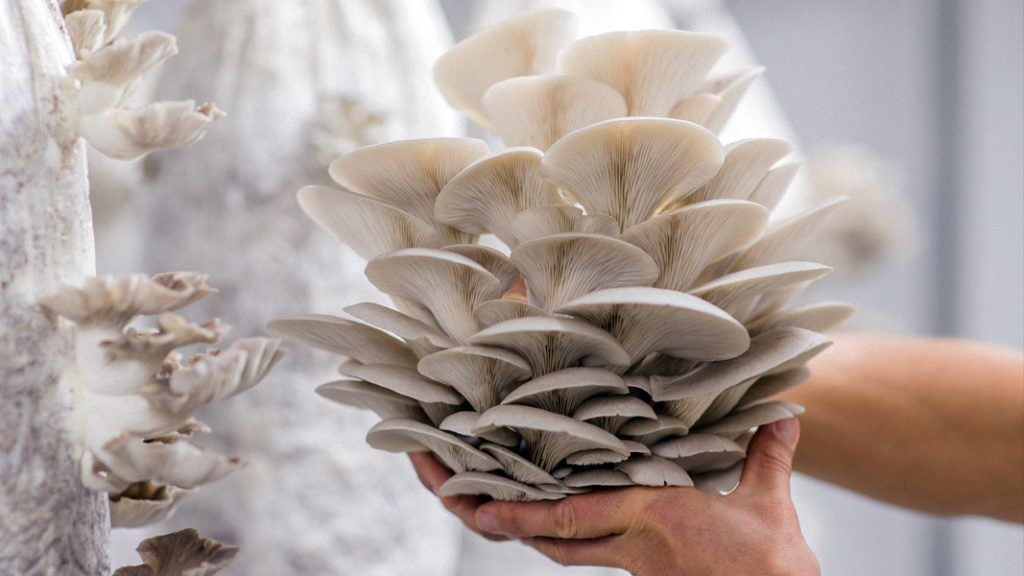I started growing mushrooms in 2007 purely for fun and as a hobby.
When I started growing them as a business in 2009, it was mainly for ideological reasons:
I wanted to be my own boss, I wanted to grow food for my living & add to the local food available in my area.
My Dad said I was too idealistic and would have to learn the hard way, and he was right (to some extent)!
But still, it was worth it. I love growing mushrooms!
Me: Idealist, 2009. Very happy with my first crop of pink oyster mushrooms!
In the years since, I’ve learnt so much about so many different things.
These days, if someone asks me if they can make a living out of growing mushrooms I usually reply that:
- It’s impossible for me to say as it depends on so many factors, and
- It can certainly be very difficult
But that’s not to say it’s impossible, nor that you or anyone else shouldn’t try.
I actually think it makes a lot of sense to grow mushrooms as a side-line income, ‘hobby-style’ business or as part of larger (community) food projects.
Mushrooms are a great high-value crop and can be grown quickly and relatively easily in small space.
Here’s a rough rule of thumb that can help you visualize the space and time needed to grow 10kg of oyster mushrooms per week.
This is a good scale to grow mushrooms without trying to make it your whole livelihood.
Before we dive into my top 5 lessons for new mushroom growers, check out this short video tour of our low-tech mushroom farm:
5 Useful Lessons
Here are 5 things I wish I knew when I set out with my bag load of ideals and no idea what I was letting myself in for:
1) You don’t need to grow mushrooms in an expensive sterile environment
When I first learned to grow mushrooms, I was told that you needed a sterile environment to grow them reliably.
I learnt that you needed to sterilize the substrate with heat, and then carry out the inoculation process in a sterile clean room.
I spent a small fortune building a lab with 5 huge pressure cookers and a filtered air flow hood.
Then I spent several weeks learning sterile tissue culture techniques.
Fast forward, and I now know that it’s absolutely possible to grow mushrooms without all that.
My guide on how to set up a low tech mushroom farm goes into more detail on this, but to summarise: there is a much easier way to grow mushrooms than is usually taught.
You can use fast growing oyster mushrooms and grow them on already pasteurised coffee grounds or sawdust pellets. Or you can pasteurize straw with simple cold-water techniques.
It’s sooo much cheaper and quicker to get setup and growing and much easier to learn.
This is a huge part of the reason why we love teaching how to grow mushrooms like this – it just makes it so much more accessible for people to get started.
My advice: just get started by growing oyster and shiitake mushrooms using low-tech methods, which don’t require such an expensive setup and steep learning curve.
If you find you really want to expand to lots of other varieties, you can always branch out and grow in the traditional sterile way later on.
2) Producing your own spawn adds lots of extra time & cost
When I first started, not only did I sterlize all my growing substrate, but I also used to produce my own spawn.
This process not only involves the same laboratory conditions, laminar flow hoods and pressure cookers but it also takes a lot of time.
It also has a number of stages in order to multiply up small amounts from petri dishes to larger quantities on grain.
As you can imagine, these kind of microbiology skills can take a lot of time and practice to get right.
A couple of years later, after struggling to juggle the workload, Eric suggested just buying in our spawn from a specialist supplier instead…and we’ve never looked back!
It cut out so much time and has enabled us to focus on others things instead. Plus, let’s face it, the quality of the spawn is better too!
My advice: just buy your spawn in and focus on growing your mushrooms and selling your produce.
It may cost a bit extra, but it will save you a lot of time (and setup expense), and enable you to focus on other important things.
If you have access to refrigeration, it’s often cheaper to buy spawn in larger quantities and, if recently made, it will keep well for 2-3 months.
3) Growing mushrooms is very labor intensive
There’s no way around it.
Growing and harvesting any food is very time and labor-intensive.
Large mushroom farms employ armies of pickers to help harvest the crop.
If you’re doing it on a small-medium scale you will be doing a lot of different tasks by hand.
And it all takes a lot of time.
Thankfully, most of the work is a lot of fun.
But if you’re not careful, you’ll quickly be running around trying to keep up with all parts of the growing process and it can be stressful.
My advice: Start Small
If you’re on your own, don’t try to grow any more than 5 -10kgs per week until you have every part of the process running smoothly.
That level of production should take around 10-12 hours per week.
If you’re working with others, you can obviously do a lot more, but it’s still wise to start small and scale up once you’ve got a feel for all parts of the process.
4) It’s a bad idea to do everything yourself
I definitely learnt this the hard way!
There’s a lot of different parts to the process of growing and selling mushrooms:
- Sourcing supplies
- Mixing & inoculating substrate
- Moving grow bags around
- Harvesting mushrooms
- Delivering to outlets
- Cleaning
- Composting spent substrate
Trying to do all of these tasks on your own can get ridiculously busy very fast, and it can make it hard to ever go away for a few days.
It can also be really lonely (no need for sad violin music..!) and hard to make decisions sometimes.
I enjoyed things so much more when Eric joined and we started working together.
My advice: find a partner in crime! Even if they are just able to help out a little bit and share the load, you will find it much easier.
If you don’t already know someone, just ask around. Lots of people will be interested to learn more and be a part of something new and interesting.
Or why not partner up with a CSA, existing charity or social enterprise already active and doing good stuff in your community.
5) Growing at the right scale is really important
So many people (and Eric and I have been guilty of this too), decide to grow mushrooms based on a calculation they did in a spreadsheet or on the back of an envelope.
This is a recipe for disaster, because this way you almost always decide to produce at a level higher than you can actually manage.
There are lots of parts to the process and these multiply and compound quickly as the scale of production increases.
Before you know, it can feel like spinning multiple plates!
You’re trying to keep them all going.
Inevitably you can’t keep up; it becomes really stressful and things go wrong.
More mushrooms = more income
BUT
More mushrooms = a lot more work
And you need more space, more labour input, and will face bigger costs.
My advice: similar to point #3 – start smaller (less than 20kg/week) and get a really good feel for what’s involved before scaling up.
Even then, only do so if you’ve got customers lined up, some extra help and you think it makes sense financially.
Conclusion & Next Steps To Get Growing
I hope after reading these that it hasn’t put you off growing mushrooms entirely!
I wrote this to share some of my experiences and because I don’t want you to end up spending money and time making mistakes I’ve made already.
The truth is, I think that small to medium scale mushroom production (5 – 20kg/week) is an excellent way to grow a high value food crop for local sale, without it becoming a headache.
You can do this as a side-line ‘hobby’ business, part-time income stream, or as part of a project. It can be done in a small space and with little set up cost.
And it can be a lot of fun too.
You get to nurture the growth of a living organism and take part in your local food scene, supplying mushrooms fresher and better than any currently available in your area.
You also get to go up against the Big Food Industry and win, and that is a very satisfying feeling .
If you want to find out more about growing mushrooms in the easiest way possible, join our free email series & get our free eBook about Low Tech Mushroom Farming by signing up below.
You might also find the following in-depth guides on our site useful:



